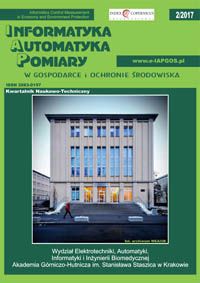ELECTRON SOURCE WITH HOT CATHODE SIMULATOR
Article Sidebar
Open full text
Issue Vol. 7 No. 2 (2017)
-
TRAFFIC ANALYSIS USING NETFLOW AND PYTHON
Vaclav Oujezsky, Tomas Horvath5-7
-
STUDY OF CONTROL INHOMOGENEITIES OF THE DIELECTRIC BETWEEN METAL PLANES OF MICROWAVE DEVICES IN PHASED ARRAY ANTENNAS
Anton Antonenko, Michael Geraimchuk8-11
-
OPTIMIZATION OF THE SOLAR COLLECTOR’S POSITION
Bogdan Sydorchuk, Oleksandr Naumchuk, Paweł Mazurek12-14
-
E-LABS – ADVANCED E-LEARNING
Jarosław Nowak, Mieczysław Pcian15-18
-
WEB SERVER LATENCY REDUCTION STUDY
Fatma Mbarek, Volodymyr Mosorov, Rafał Wojciechowski19-23
-
TOPOGRAPHY DEPENDENT VERTICAL WIND DISTRIBUTION ESTIMATION
Karolina Lamkowska, Piotr Domagalski24-27
-
SYSTEM FOR VEHICLE ROUTING PROBLEM ALGORITHMS ANALYSIS
Wiktor Sztajerowski, Joanna Ochelska-Mierzejewska, Jacek Kucharski28-31
-
DEVELOPMENT OF THE INTERNET OF THINGS IN POLAND WITH SPECIAL CONSIDERATION OF THE SOCIETY’S AWARENESS OF THE IOT
Szczepan Paszkiel, Maciej Matusik32-35
-
INVESTMENT PROFITABILITY ANALYSIS OF AN ON-GRID PHOTOVOLTAIC SYSTEM
Piotr Szpulak, Szczepan Paszkiel, Stanisław Wawrzyniak, Mirosław Gryszpiński36-39
-
SYNTHESIS OF INTELLECTUAL SUBSYSTEMS OF DYNAMIC DIAGNOSIS OF THE CONDITION OF TURBINE UNITS THERMAL POWER
Alibek Suleimenov , Batyrbek Suleimenov, Oxana Zhirnova, Aituar Suleimenov40-43
-
ANALYSIS OF APPLIED REFERENCE LEADS INFLUENCE ON AN EEG SPECTRUM
Małgorzata Plechawska-Wójcik, Kinga Wesołowska, Martyna Wawrzyk, Monika Kaczorowska, Mikhail Tokovarov44-49
-
PERFORMANCE ANALYSIS OF NATIVE AND CROSS-PLATFORM MOBILE APPLICATIONS
Paweł Grzmil , Maria Skublewska-Paszkowska, Edyta Łukasik, Jakub Smołka50-53
-
ELECTRON SOURCE WITH HOT CATHODE SIMULATOR
Bartosz Kania54-57
-
SMART HOME IMPLEMENTATION COMPARISON ON DIFFERENT HARDWARE PLATFORMS
Piotr Pańczyk, Jakub Smołka58-61
-
THEORETICAL AND EXPERIMENTAL STUDY OF INCOMPRESSIBLE FLUID FLOW THROUGH A SLOTTED ORIFICE
Barbara Tomaszewska62-65
-
ANALYSIS OF INFLUENCE OF NUMERICAL MESH DENSITY ON RESULTS OF SIMULATION OF VON KARMAN VORTEX STREET
Beata Czapla, Mariusz Rząsa66-69
-
INVESTIGATION OF SOIL PARAMETERS FROM WATER AREA
Olena Nesteruk, Mirosław Łabuz, Andrzej Wal70-73
-
CONVERSION EFFICENCY OF THE YAG:CE LUMINOPHORES COOPERATED WITH UV-VIS SEMICONDUTOR EMMITERS
Mateusz Prorok74-77
-
ANALYSIS OF THE USE OF SELECTED ENGINEERING SIMULATION TOOLS FOR MODELING DAYLIGHT
Ewa Piotrowska78-87
-
ANOMALIES IN MODELLING BUSINESS PROCESS
Anna Suchenia, Antoni Ligęza88-93
-
CONCEPT OF CONTROL SYSTEM FOR HYBRID ELECTROMAGNETIC LAUNCHER WITH USE OF REAL TIME CONTROLLER
Tomasz Makowski94-97
-
IMPLEMENTATION OF THE SYSTEM WWS IS THE REQUIREMENT IN DEVELOPMENT OF ELECTROMOBILITY
Krzysztof Polakowski98-101
-
EMOTION RECOGNITION IN POLISH TEXTS BASED ON KEYWORDS DETECTION METHOD
Adrian Maciej Nowaczyk, Lidia Jackowska-Strumiłło102-105
-
CONSTRUCTION OF VACUUM CIRCUIT-BREAKER FOR 7.2 KV
Artur Hejduk106-109
-
ANALYSIS OF LOGARITHMIC ANALOG-TO-DIGITAL CONVERTER WITH SUCCESSIVE APPROXIMATION TAKING INTO ACCOUNT PARASITIC CAPACITANCES
Adam Szcześniak, Zynowij Myczuda110-114
-
CONSTRUCTION SOLUTIONS ROTATIONAL MOLDING MACHINES POLYMER MATERIALS
Karolina Głogowska115-118
-
TESTING FOR REVEALING OF DATA STRUCTURE BASED ON THE HYBRID APPROACH
Volodymyr Mosorov, Taras Panskyi, Sebastian Biedron119-122
Archives
-
Vol. 9 No. 4
2019-12-16 20
-
Vol. 9 No. 3
2019-09-26 20
-
Vol. 9 No. 2
2019-06-21 16
-
Vol. 9 No. 1
2019-03-03 13
-
Vol. 8 No. 4
2018-12-16 16
-
Vol. 8 No. 3
2018-09-25 16
-
Vol. 8 No. 2
2018-05-30 18
-
Vol. 8 No. 1
2018-02-28 18
-
Vol. 7 No. 4
2017-12-21 23
-
Vol. 7 No. 3
2017-09-30 24
-
Vol. 7 No. 2
2017-06-30 27
-
Vol. 7 No. 1
2017-03-03 33
-
Vol. 6 No. 4
2016-12-22 16
-
Vol. 6 No. 3
2016-08-08 18
-
Vol. 6 No. 2
2016-05-10 16
-
Vol. 6 No. 1
2016-02-04 16
-
Vol. 5 No. 4
2015-10-28 19
-
Vol. 5 No. 3
2015-09-02 17
-
Vol. 5 No. 2
2015-06-30 15
-
Vol. 5 No. 1
2015-03-31 18
Main Article Content
DOI
Authors
Abstract
Paper contains electron source with hot cathode simulator description. Simulator is made using LabView environment and it is based on static model of source. It is developed for different types of filaments used in vacuum instruments in order to enable easy and fast numerical calculations which are very useful in thermionic emission current controller designing process. Simulator, among other things, calculates temperature and electron emission current distribution along filament in steady state.
Keywords:
References
Donkov N., Knapp W.: Control of hot-filament ionization gauge emission current: mathematical model and model-based controller. Measurement Science and Technology 8/1997, 798–803, [DOI: 10.1088/0957-0233/8/7/016].
Durakiewicz T., Hałas S.: Computation of time-dependent temperature distribution along a filament heated in vacuo by electric pulses. Journal of Vacuum Science & Technology 16/1998, 194, [DOI: 10.1116/1.580968].
Hałas S., Durakiewicz T.: Temperature distribution along a metal filament heated in vacuum by DC current. Vacuum 49/1998, 331–336, [DOI: 10.1016/S0042-207X(97)00170-X].
Kmieć A.: Procesy cieplne i aparaty. OWPW, Wrocław 2005.
Krolopp W., Sikora J., Hałas S.: Simplified dynamic model of electron source with a hot filament. Journal of Technical Physics 1/1997, 87–95.
Langmuir I.: The effect of end loses on the characteristics of filaments of tungsten and other materials. Physical Review 35/1930, 478, [DOI: 10.1103/PhysRev.35.478].
Smithells Metals Reference Book, Butterworths, London, 1967.
Article Details
Abstract views: 317
License

This work is licensed under a Creative Commons Attribution-ShareAlike 4.0 International License.






